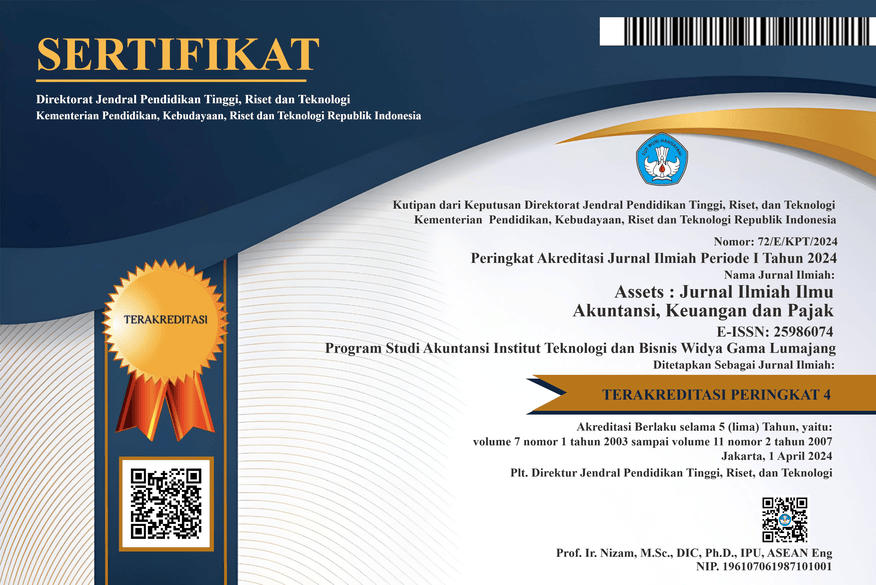DETERMINANT OF FRAUD PENTAGON IN DETECTING FINANCE OF FINANCIAL STATEMENTS
DOI:
https://doi.org/10.30741/assets.v4i1.563Keywords:
pressure, opportunity, rationalization, competence, arroganceAbstract
This study aims to determine the Pentagon Determinant Fraud in detecting fraudulent financial statements. Fraudulent financial statements are proxied by the Fraud Score Model. Whereas the pressure factor is proxied by insisting from within, for the opportunity factor proxied by industry conditions, the rationalization factor is proxied by the ratio of total accruals, the competency factor is proxied by the change of directors and arrogance is proxied by the duality of quality positions at the CEO. The population in this study amounted to 100 companies incorporated in the compass index 100 contained in the Indonesia Stock Exchange and for the sample of the study were 35 companies belonging to the compass index 100 contained in the Indonesia Stock Exchange, which was selected using the purposive sampling method for the 2017-2018 period. Data were analyzed using multiple linear regression. Based on the test results, it was concluded that the pentagon fraud component included internal pressure (LEV), industry conditions (INVENTORY), rationalization (TATA) influencing financial statement fraud while competence (DCHANGE) and arrogance (DCD) had no effect on financial fraud statement. This proves that internal pressure (LEV), industry conditions (INVENTORY), and rationalization (TATA) can be used to detect fraud in financial statements.
Downloads
References
Agustina, R. D., & Pratomo, D. (2019). Pengaruh Fraud Pentagon Dalam Mendeteksi Kecurangan Pelaporan Keuangan. Jurnal Ilmiah Manajemen, Ekonomi, & Akuntansi (MEA), 3(1), 44–62. https://doi.org/10.31955/mea.vol3.iss1.pp44-62
Arens, A.A; Elder, R.J;Beasley, M. . (2011). Auditing & Jasa Assurance. Salemba Empat.
Bawekes, H. F., Simanjuntak, A. M. A., & Daat, S. C. (2018). Pengujian Teori Fraud Pentagon Terhadap Fraudulent Financial Reporting (Studi Empiris pada Perusahaan yang Terdaftar di Bursa Efek Indonesia Tahun 2011-2015). Jurnal Akuntansi & Keuangan Daerah, 13(1), 114–134.
Cressey, D. (1953). Encyclopedia of Criminological Theory Cressey, Donald R.: Embezzlement and White-Collar Crime Contributors:
Damayani, F., Wahyudi, T., & Yuniartie, E. (2019). Pengaruh Fraud Pentagon Terhadap Kecurangan Laporan Keuangan Pada Perusahaan Infrastruktur Yangterdaftar Di Bursa Efek Indonesiatahun 2014 – 2016. AKUNTABILITAS: Jurnal Penelitian Dan Pengembangan Akuntansi, 11(2), 151–170. https://doi.org/10.29259/ja.v11i2.8936
Fitrawansyah. (2014). Fraud & Auditing. Mitra Wacana Media.
Ghozali, I. (2016). Aplikasi Analisis Multivariete Dengan Program IBM SPSS 23. Badan Penerbit Universitas Diponegoro.
Gunawan, I. (2017). Pengantar Statistik Inferensial Ed. 1, Cet. 2. Raja Grafindo Persada.
Ismawati, D; Krisnawati, L. (2017). Analisis Fraud Pentagon Pada Financial Statement Fraud Menggunakan Beneish M-Score Dan F-score. ABA Journal, 102(4), 24–25. https://doi.org/10.1002/ejsp.2570
Nasution, M; Suryani, E; Lestari, T. (2019). Pengaruh Fraud Pentagon Terhadap Kecurangan Laporan Keuangan (Studi Pada Perusahaan Manufaktur Sub Sektor Makanan Dan Minuman Yang Terdaftar Di Bursa Efek Indonesia). Jurnal Aksara Public, 3, 5–10.
Paramita, R; Rizal, N. (2018). Metode Penelitian Kuantitatif. AZYAN MITRA MEDIA.
Pardosi, R. W. (2015). Analis Fraud Diamond Dalam Mendeteksi Kecurangan Laporan Keuangan Pada Perusahaan Manufaktur Di Indonesia Dengan Menggunakan Fraud Score Model Tahun 2010-2013. Skripsi, 53(9), 1–72. https://doi.org/10.1017/CBO9781107415324.004
Pratiwi, N; Nurbaiti, A. (2018). Analisis Fraud Pentagon Dalam Mendeteksi Kecurangan Laporan Keuangan Dengan Metode F-Score Model (Studi Empiris Pada Perusahaan Pertambangan Yang Terdaftar Di Bursa Efek Indonesia. E- Proceeding of Management, 03(01), 18–31.
Rahmawati, M. (2013). Pendeteksian Kecurangan Laporan Keuangan Melalui Faktor Risiko Tekanan Dan Peluang (Studi Kasus pada Perusahaan yang Mendapat Sanksi dari Bapepam Periode 2002-2006). Diponegoro Jurnal Of Accounting, 2, 700–711.
Ratnasari, E; Solikhah, B. (2019). Analysis Of Fraudulent Financial Statement: The Fraud Pentagon Theory Approach Analisis Kecurangan Laporan Keuangan: Pendekatan Fraud Pentagon Theory. Gorontalo Accounting Journal (GAJ, 2(2), 98–112.
Sasongko, N., & Wijayantika, S. F. (2019). Faktor Resiko Fraud Terhadap Pelaksanaan Fraudulent Financial Reporting (Berdasarkan Pendekatan Crown’S Fraud Pentagon Theory). Riset Akuntansi Dan Keuangan Indonesia, 4(1), 67–76. https://doi.org/10.23917/reaksi.v4i1.7809
Septriani, Yossi; Handayani, D. (2018). Mendeteksi Kecurangan Laporan Keuangan dengan Analisis Fraud Pentagon. Jurnal Akuntansi, Keuangan Dan Bisnis, 11(1), 11–23. http://jurnal.pcr.ac.id
Setiawati, E., & Baningrum, R. M. (2018). Deteksi Fraudulent Financial Reporting Menggunakan Analisis Fraud Pentagon : Studi Kasus Pada Perusahaan Manufaktur Yang Listed Di BEI Tahun 2014-2016 Riset Akuntansi dan Keuangan Indonesia , 3 ( 2 ), 2018. Riset Akuntansi Dan Keuangan Indonesia, 3(1953), 91–106.
Siddiq, F; Suseno, A. (2019). Fraud Pentagon Teori Dalam Financial Statement Fraud Pada Perusahaan Terdaftar Di Jakarta Islamic Indek (JII) Periode 2014-2017. Jurnal Nusamba, 4(2), 128–138. https://doi.org/10.29407/nusamba.v4i2.13800
Skousen, C. J., & Wright, C. J. (2011). Contemporaneous Risk Factors and the Prediction of Financial Statement Fraud. In SSRN Electronic Journal. https://doi.org/10.2139/ssrn.938736
Suliyanto, H. (2008). Manajemen Laba. Grasindo.
Ulfah, M., Nuraina, E., & Wijaya, A. L. (2017). Pengaruh Fraud Pentagon dalam Mendeteksi Fraudulent Financial Reporting (Studi Empiris pada Perbankan di Indonesia yang Terdaftar di BEI). The 9th Forum Ilmiah Pendidikan Akuntansi (FIPA), VOL 5 NO 1, 399–418. http://prosiding.unipma.ac.id/index.php/FIPA/article/viewFile/291/272
Wolfe, D. T., & Hermanson, D. R. (2004). The Fraud Diamond : Considering the Four Elements of Fraud: Certified Public Accountant. The CPA Journal, 74(12), 38–42. https://doi.org/DOI:
Downloads
Published
How to Cite
Issue
Section
License
Copyright (c) 2020 Muhammad Bagus, Noviansyah Rizal, Siwidyah Desi Lastianti

This work is licensed under a Creative Commons Attribution-NonCommercial 4.0 International License.









